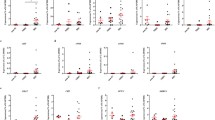Abstract
Urethral fibrosis is an important pathological feature of urethral stricture. TGF-β1 and CXC chemokine receptor 3 (CXCR3) signaling have been reported as the critical pathways involved in the pathology of fibrosis. Here, we collected the urine samples from the patients with recurring urethral stricture, recurring stricture treated by cystostomy, and age- and gender-matched healthy people. ELISA detection revealed that TGF-β1 level was significantly up-regulated for the urethral stricture patients. By contrast, flow cytometry, real-time PCR detection, and immunofluoresecent staining showed that urethral stricture resulted in decreased expression of CXCR3. TGF-β1 treatment could increase cell proliferation and migration ability of urethra fibroblasts, whereas IP-10/CXCR3 signaling showed the opposite effect. Further, we found a crosstalk between TGF-β1 and CXCR3 signaling in the regulation of urethral fibrosis. Thus, pharmacological intervention of TGF-β1 or CXCR3 signaling has a potential as the therapeutic target for the prevention of urethral fibrosis.




Similar content being viewed by others
References
Tonkin JB, Jordan GH (2009) Management of distal anterior urethral strictures. Nat Rev Urol 6(10):533–538
Peterson AC, Webster GD (2004) Management of urethral stricture disease: developing options for surgical intervention. BJU Int 94(7):971–976
Melekos MD, Naber KG (2000) Complicated urinary tract infections. Int J Antimicrob Agents 15(4):247–256
Jaidane M, Ali-El-Dein B, Ounaies A, Hafez AT, Mohsen T, Bazeed M (2003) The use of halofuginone in limiting urethral stricture formation and recurrence: an experimental study in rabbits. J Urol 170(5):2049–2052
Da-Silva EA, Sampaio FJ, Dornas MC, DamiÃO R, Cardoso LE (2002) Extracellular matrix changes in urethral stricture disease. J Urol 168(2):805–807
El-Kassaby AW, Retik AB, Yoo JJ, Atala A (2003) Urethral stricture repair with an off-the-shelf collagen matrix. J Urol 169(1):170–173
Joseph JV, Andrich DE, Leach CJ, Mundy AR (2002) Urethroplasty for refractory anterior urethral stricture. J Urol 167(1):127–129
Herpin A, Lelong C, Favrel P (2004) Transforming growth factor-β-related proteins: an ancestral and widespread superfamily of cytokines in metazoans. Dev Comp Immunol 28(5):461–485
Pohlers D, Brenmoehl J, Löffler I et al (2009) TGF-β and fibrosis in different organs—molecular pathway imprints. Biochim Biophys Acta 1792(8):746–756
Leask A, Abraham DJ (2004) TGF-β signaling and the fibrotic response. FASEB J 18(7):816–827
Martin M, Lefaix J-L, Delanian S (2000) TGF-β1 and radiation fibrosis: a master switch and a specific therapeutic target? Int J Radiat Oncol Biol Phys 47(2):277–290
Liu L, Callahan MK, Huang D, Ransohoff RM (2005) Chemokine receptor CXCR3: an unexpected enigma. Curr Top Dev Biol 68:149–181
Morgia G, Saita A, Falsaperla M, Spampinato A, Motta M, Cordaro S (2000) Immunohistochemical and molecular analysis in recurrent urethral stricture. Urol Res 28(5):319–322
Yates CC, Krishna P, Whaley D, Bodnar R, Turner T, Wells A (2010) Lack of CXC chemokine receptor 3 signaling leads to hypertrophic and hypercellular scarring. Am J Pathol 176(4):1743–1755
Ivaska J, Pallari H-M, Nevo J, Eriksson JE (2007) Novel functions of vimentin in cell adhesion, migration, and signaling. Exp Cell Res 313(10):2050–2062
Dufour JH, Dziejman M, Liu MT, Leung JH, Lane TE, Luster AD (2002) IFN-γ-inducible protein 10 (IP-10; CXCL10)-deficient mice reveal a role for IP-10 in effector T cell generation and trafficking. J Immunol 168(7):3195–3204
Booth V, Keizer DW, Kamphuis MB, Clark-Lewis I, Sykes BD (2002) The CXCR3 binding chemokine IP-10/CXCL10: structure and receptor interactions. Biochemistry 41(33):10418–10425
Lumen N, Hoebeke P, Willemsen P, De Troyer B, Pieters R, Oosterlinck W (2009) Etiology of urethral stricture disease in the 21st century. J Urol 182(3):983–987
Heyns C, Steenkamp J, De Kock M, Whitaker P (1998) Treatment of male urethral strictures: is repeated dilation or internal urethrotomy useful? J Urol 160(2):356–358
Waxman SW, Morey AF (2006) Management of urethral strictures. Lancet 367(9520):1379–1380
Brandes SB (2008) Epidemiology, etiology, histology, classification, and economic impact of urethral stricture disease. Brandes SB(ed) Urethral reconstructive surgery. Springer, New York, pp 53–61
Ruiz-Ortega M, Rodríguez-Vita J, Sanchez-Lopez E, Carvajal G, Egido J (2007) TGF-β signaling in vascular fibrosis. Cardiovasc Res 74(2):196–206
Roos N, Poulalhon N, Farge D, Madelaine I, Mauviel A, Verrecchia F (2007) In vitro evidence for a direct antifibrotic role of the immunosuppressive drug mycophenolate mofetil. J Pharmacol Exp Ther 321(2):583–589
Groom JR, Luster AD (2011) CXCR3 ligands: redundant, collaborative and antagonistic functions. Immunol Cell Biol 89(2):207–215
Jiang D, Liang J, Hodge J et al (2004) Regulation of pulmonary fibrosis by chemokine receptor CXCR3. J Clin Invest 114(2):291–299
Zeremski M, Petrovic LM, Chiriboga L et al (2008) Intrahepatic levels of CXCR3-associated chemokines correlate with liver inflammation and fibrosis in chronic hepatitis C. Hepatology 48(5):1440–1450
Nakaya I, Wada T, Furuichi K et al (2007) Blockade of IP-10/CXCR3 promotes progressive renal fibrosis. Nephron Exp Nephrol 107(1):e12–e21
Author information
Authors and Affiliations
Corresponding author
Rights and permissions
About this article
Cite this article
Xie, H., Feng, C., Fu, Q. et al. Crosstalk between TGF-β1 and CXCR3 signaling during urethral fibrosis. Mol Cell Biochem 394, 283–290 (2014). https://doi.org/10.1007/s11010-014-2104-5
Received:
Accepted:
Published:
Issue Date:
DOI: https://doi.org/10.1007/s11010-014-2104-5




